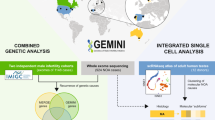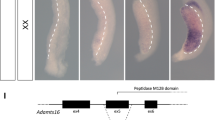Abstract
Genome-wide mutagenesis was performed in mice to identify candidate genes for male infertility, for which the predominant causes remain idiopathic. Mice were mutagenized using N-ethyl-N-nitrosourea (ENU), bred, and screened for phenotypes associated with the male urogenital system. Fifteen heritable lines were isolated and chromosomal loci were assigned using low-density genome-wide SNP arrays. Ten of the 15 lines were pursued further using higher-resolution SNP analysis to narrow the candidate gene regions. Exon sequencing of candidate genes identified mutations in mice with cystic kidneys (Bicc1), cryptorchidism (Rxfp2), restricted germ cell deficiency (Plk4), and severe germ cell deficiency (Prdm9). In two other lines with severe hypogonadism, candidate sequencing failed to identify mutations, suggesting defects in genes with previously undocumented roles in gonadal function. These genomic intervals were sequenced in their entirety and a candidate mutation was identified in SnrpE in one of the two lines. The line harboring the SnrpE variant retains substantial spermatogenesis despite small testis size, an unusual phenotype. In addition to the reproductive defects, heritable phenotypes were observed in mice with ataxia (Myo5a), tremors (Pmp22), growth retardation (unknown gene), and hydrocephalus (unknown gene). These results demonstrate that the ENU screen is an effective tool for identifying potential causes of male infertility.




Similar content being viewed by others
References
Acevedo-Arozena A et al (2008) ENU mutagenesis, a way forward to understand gene function. Annu Rev Genomics Hum Genet 9:49–69
Bannister LA et al (2007) A dominant, recombination-defective allele of Dmc1 causing male-specific sterility. PLoS Biol 5:e105
Baudat F et al (2010) PRDM9 is a major determinant of meiotic recombination hotspots in humans and mice. Science 327:836–840
Boles MK et al (2009) Discovery of candidate disease genes in ENU-induced mouse mutants by large-scale sequencing, including a splice-site mutation in nucleoredoxin. PLoS Genet 5:e1000759
Brugh VM III, Lipschultz LI (2004) Male factor infertility: evaluation and management. Med Clin North Am 88:367–385
Ching YH et al (2010a) High resolution mapping and positional cloning of ENU-induced mutations in the Rw region of mouse chromosome 5. BMC Genet 11:106
Ching YH et al (2010b) An allele separating skeletal patterning and spermatogonial renewal functions of PLZF. BMC Dev Biol 10:33
Church DM et al (2009) Lineage-specific biology revealed by a finished genome assembly of the mouse. PLoS Biol 7:e1000112
Clark AT et al (2004) Implementing large-scale ENU mutagenesis screens in North America. Genetica 122:51–64
Debruyne JP et al (2006) A clock shock: mouse CLOCK is not required for circadian oscillator function. Neuron 50:465–477
Durbin RM et al (2010) A map of human genome variation from population-scale sequencing. Nature 467:1061–1073
Fautsch MP et al (1992) Conservation of coding and transcriptional control sequences within the snRNP E protein gene. Genomics 14:883–890
Ferlin A et al (2003) The INSL3-LGR8/GREAT ligand-receptor pair in human cryptorchidism. J Clin Endocrinol Metab 88:4273–4279
Foresta C et al (2002) Guidelines for the appropriate use of genetic tests in infertile couples. Eur J Hum Genet 10:303–312
Furnes B, Schimenti J (2007) Fast forward to new genes in mammalian reproduction. J Physiol 578:25–32
Guenet JL (2004) Chemical mutagenesis of the mouse genome: an overview. Genetica 122:9–24
Handel MA et al (2006) Mutagenesis as an unbiased approach to identify novel contraceptive targets. Mol Cell Endocrinol 250:201–205
Harris T et al (2007) Sperm motility defects and infertility in male mice with a mutation in Nsun7, a member of the Sun domain-containing family of putative RNA methyltransferases. Biol Reprod 77:376–382
Harris RM et al (2010) A missense mutation in LRR8 of RXFP2 is associated with cryptorchidism. Mamm Genome 21:442–449
Harris RM et al (2011) Male hypogonadism and germ cell loss caused by a mutation in Polo-like kinase 4. Endocrinology 152:3975–3985
Hayashi K et al (2005) A histone H3 methyltransferase controls epigenetic events required for meiotic prophase. Nature 438:374–378
Irvine DS (1998) Epidemiology and aetiology of male infertility. Hum Reprod 13(Suppl 1):33–44
Jongeneel CV et al (2005) An atlas of human gene expression from massively parallel signature sequencing (MPSS). Genome Res 15:1007–1014
Justice MJ et al (1999) Mouse ENU mutagenesis. Hum Mol Genet 8:1955–1963
Kennedy CL, O’Bryan MK (2006) N-ethyl-N-nitrosourea (ENU) mutagenesis and male fertility research. Hum Reprod Update 12:293–301
Kuroda-Kawaguchi T et al (2001) The AZFc region of the Y chromosome features massive palindromes and uniform recurrent deletions in infertile men. Nat Genet 29:279–286
Lander ES et al (2001) Initial sequencing and analysis of the human genome. Nature 409:860–921
Matzuk MM et al (2008) The biology of infertility: research advances and clinical challenges. Nat Med 14:1197–1213
Mihola O et al (2009) A mouse speciation gene encodes a meiotic histone H3 methyltransferase. Science 323:373–375
Moldin SO et al (2001) Trans-NIH neuroscience initiatives on mouse phenotyping and mutagenesis. Mamm Genome 12:575–581
Moran JL et al (2006) Utilization of a whole genome SNP panel for efficient genetic mapping in the mouse. Genome Res 16:436–440
O’Bryan MK, de Kretser D (2006) Mouse models for genes involved in impaired spermatogenesis. Int J Androl 29:76–89 discussion 105–108
O’Flynn O’Brien KL et al (2010) The genetic causes of male factor infertility: a review. Fertil Steril 93:1–12
Parvanov ED et al (2010) Prdm9 controls activation of mammalian recombination hotspots. Science 327:835
Philipps DL et al (2008) The dual bromodomain and WD repeat-containing mouse protein BRWD1 is required for normal spermiogenesis and the oocyte-embryo transition. Dev Biol 317:72–82
Raverot G et al (2005) Sox3 expression in undifferentiated spermatogonia is required for the progression of spermatogenesis. Dev Biol 283:215–225
Stanford DR et al (1988) The complete primary structure of the human snRNP E protein. Nucleic Acids Res 16:10593–10605
Tyler-Smith C et al (2009) The will-o’-the-wisp of genetics–hunting for the azoospermia factor gene. N Engl J Med 360:925–927
Venter JC et al (2001) The sequence of the human genome. Science 291:1304–1351
Vitaterna MH et al (1994) Mutagenesis and mapping of a mouse gene, Clock, essential for circadian behavior. Science 264:719–725
Vitaterna MH et al (2006) Large-scale mutagenesis and phenotypic screens for the nervous system and behavior in mice. Trends Neurosci 29:233–240
Ward JO et al (2007) Mutation in mouse hei10, an e3 ubiquitin ligase, disrupts meiotic crossing over. PLoS Genet 3:e139
Waterston RH et al (2002) Initial sequencing and comparative analysis of the mouse genome. Nature 420:520–562
Acknowledgments
This work was supported by NIH grants U01 HD043425 (JLJ) and U01 HD43430 (DRB); by the Northwestern University Genomics Core, which is supported by a Cancer Center Support Grant (NCI CA060553); and by the Northwestern University Biostatistics Collaboration Center, which is supported by a grant from the National Center for Research Resources (UL1 RR025741). The authors thank Timothy Barrett and Donna Emge for exceptional technical assistance.
Author information
Authors and Affiliations
Corresponding author
Rights and permissions
About this article
Cite this article
Weiss, J., Hurley, L.A., Harris, R.M. et al. ENU mutagenesis in mice identifies candidate genes for hypogonadism. Mamm Genome 23, 346–355 (2012). https://doi.org/10.1007/s00335-011-9388-5
Received:
Accepted:
Published:
Issue Date:
DOI: https://doi.org/10.1007/s00335-011-9388-5




